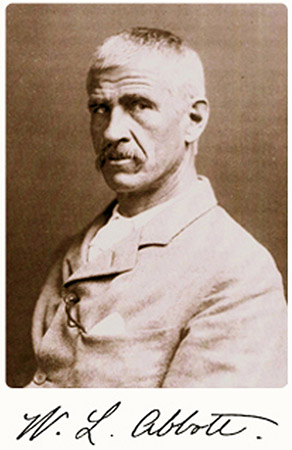William Louis Abbott
Contents
Notes
Office Notes
House Notes
Proposed by C. Boden Kloss; seconded by Henry Balfour 1903.11.10
[one t in 1903 list]
Notes From Elsewhere
William Louis Abbott (23 February 1860 – 2 April 1936) was an American medical doctor, explorer, ornithologist and field naturalist. He complied prodigious collections of biological specimens and ethnological artefacts from around the world, especially from Maritime Southeast Asia, and was a significant financial supporter of the United States National Museum collecting expeditions.
Abbot was born in Philadelphia.[1] He obtained a Bachelor of Arts at the University of Pennsylvania in 1881 before studying medicine there, graduating in 1884 and subsequently doing postgraduate studies in England, obtaining licentiates from the Royal College of Physicians and Royal College of Surgeons. In 1886 he received a substantial inheritance, ceased the formal practice of medicine, and devoted himself to exploration and collecting
Journeys of exploration and collecting made by Abbott include:[2]
· 1880 – · Bird collecting in · Iowa and · North Dakota
· 1883 – Bird collecting in · Cuba and · Santo Domingo
· 1887–89 – · Taveta region, near · Mount Kilimanjaro, in · Kenya, · East Africa
· 1890 – · Zanzibar, · Seychelles and · Madagascar
· 1891 – · India: · Baltistan, · Karachi, · Kashmir and · Srinagar
· 1892 – Kashmir, Baltistan, · Aden, Seychelles and the · Aldabra Group
· 1893 – Seychelles, Kashmir, Srinagar, · Ladakh, · Sinkiang and eastern · Turkestan
· 1894 – As well as travelling in eastern Turkestan, India and · Ceylon, he went to Madagascar to enlist in the native "Hova" army against the second · French occupation of the island, until local suspicion of foreigners forced his resignation· [4]
· 1895 – Madagascar and Kashmir
· 1896 – · Malay Peninsula including · Perak, · Penang and · Trang, with a visit to · Canton
· 1897 – Trang, Penang and India
· 1898 – As well as volunteering for the · Spanish–American War and serving under · William A. Chanler in Cuba,· [5] where he was wounded in the · Battle of Tayacoba, he traveled to · Singapore and · China, making a visit to · Tibet· [4]
· 1899 – Abbott constructed the · schooner "Terrapin" and, using Singapore as a base for the next ten years, travelled throughout the islands of · Maritime Southeast Asia often accompanied by · Cecil Boden Kloss. Places visited include the · Mergui Archipelago, · Natuna Islands, the · Andaman and · Nicobar Islands, · Burma, · Malaya, · Sumatra, · Borneo, · Nias, the · Mentawai Islands, · Enggano, the · Riau Archipelago and islands in the · South China and · Java Seas.· [2]
· 1909 – The onset of partial · blindness, caused by · spirochetosis, forced him to sell the "Terrapin" and largely suspend his collecting in the · tropics. After treatment in Germany, from 1910 to 1915, he travelled in Kashmir, though making a brief collecting visit to the · Maluku Islands and · Sulawesi with his sister in 1914.· [2]
· 1916 – · Dominican Republic
· 1917–18 – · Haiti, where he suffered a near-fatal attack of · dysentery
· 1919–23 – · Hispaniola
In 1923, Abbott retired from active fieldwork but continued to provide funding on several occasions to the United States National Museum for other collecting expeditions.
He died at his farm on the Elk River in Maryland of heart disease after a long illness, leaving his books, papers and 20% of his estate to the Smithsonian Institution.[2] At the time of his death he was the largest single contributor to the collections of the museum.[6] Abbott’s name is commemorated in the names of numerous animal taxa, including those of Abbott's crested lizard (Gonocephalus abbotti), Abbott's day gecko (Phelsuma abbotti), Abbott's booby (Papasula abbotti), Abbott's starling (Cinnyricinclus femoralis), pygmy cuckoo-shrike (Coracina abbotti), Abbott's sunbird (Cinnyris sovimanga abbotti) and Abbott's duiker (Cephalophus spadix). Plants named after him include Cyathea abbottii, a tree-fern native to Hispaniola
Publications
External Publications
House Publications
Related Material Details
RAI Material
Other Material
Smithsonian
